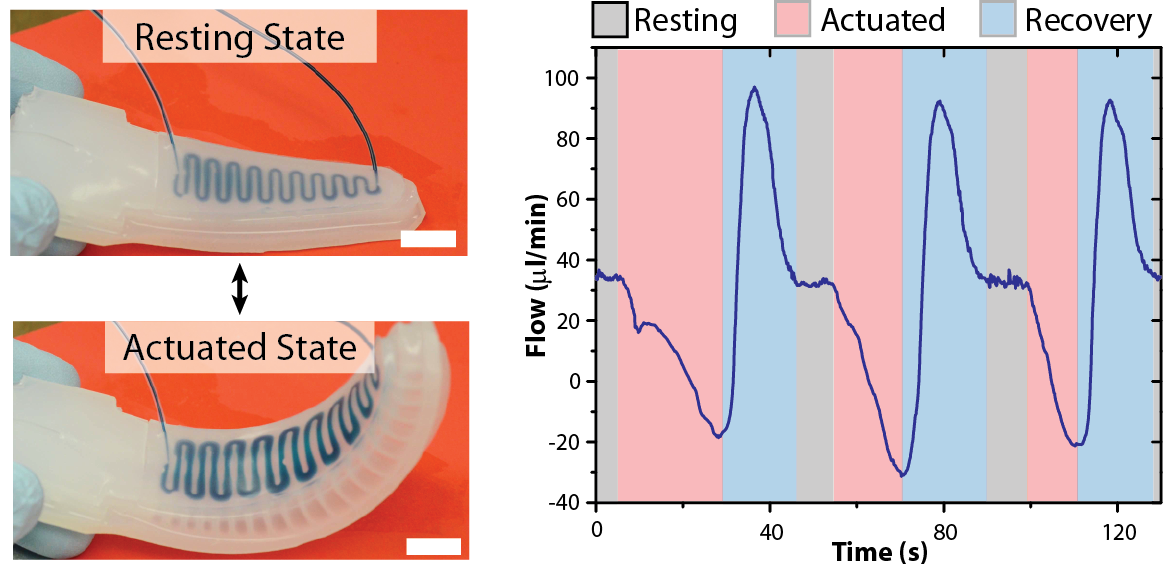Caption: Flow-enabled Sensing in Soft Robotic Systems. Scale bar: 10mm
The innovations in automation over the past five decades have been remarkable, specifically in the field of robotics. In automation, robotics is a rapidly evolving field of study and one of the most researched area. Germany, Singapore, and South Korea are aggressively working in the robotics revolution, followed by Japan, China, the US, and Australia. The term ‘robot’ was associated with chains of rigid links up till the year 2010. Research in robotics was limited to rigid structures and their functionality. In the last decade, things took a new turn in the field of robotics when soft robotics came into the picture. Octobot, the world’s first soft, autonomous, and untethered robot, stirred hype in the industry and directed the attention of robotics research to it.
The Untapped Potential of Soft Robotics
Not many people are aware of the term ‘soft robotics.’ Even today, people associate robots with rigid structures. For people who are unaware of this term, soft robots are constructed with easily deformable materials. These materials include but are not limited to fluids, elastomers, and gels. The primary aim of soft robotics is to mimic the locomotion mechanisms of natural soft bodies such as snakes, larva, earthworms, eels, and octopus. It is a growing field, and the technologists aim to use these robots in applications where conventional rigid robots fail to assist.
Material scientists, biomedical engineers, and mechanical engineers are working in this field to create more adaptable and sensitive robots. The research has come a long way since the introduction of Octobot in the market. The Wyss Institute of MIT and Harvard was successful in creating an artificial muscle system that could lift a weight that was 1000 times more than its own weight. Many researchers were able to develop soft lifters and grips based on origami folds. Some soft robotic researchers created programmable multi-directional robotic mechanisms in less than ten minutes using materials that did not cost more than $1.
Wearable exosuits are another product of soft robotics. It was created by the scientists from Harvard’s Biodesign Lab. These suits make it possible for people with severe injuries to walk independently. Moreover, these suits can now adapt to the wearers walking style. Researchers are working to make this version of the soft robot by researching on self-healing materials to enhance its durability. Engineers from Belgium at the Vrije Universiteit Brussel displayed how they can achieve this using a self-repairing material that can repair itself within 40 minutes when heat is applied.
Besides all these innovations, there is another area that has gained the attention of scientists—soft robotics integrated with Microfluidics. It is a topic of importance for researchers in soft robotics as it has shown the potential to imbibe camouflage and sensing capabilities in soft robotic systems.
Convergence of Microfluidics in Soft Robotic Systems
Microfluidics is a field of study that revolves around the behavior, manipulation, and precise control of fluids in microchannel networks. It governs geometrically constrained fluids to a small scale. It is a field that is influencing major areas such as medical diagnostics, chemical and biological sciences, and soft robotics. Microfluidic devices are typically made out of elastomeric, rubber-like polymers and when the mechanical deformation of these elastic microchannel networks is understood, it can lead to soft-robotic systems with integrated sensing capabilites.
Microchannel networks when connected to soft robots are affected by deformation during actuation and operation of the robot. It has become difficult for researchers and scientists to sense deformations in soft robots. A popular approach in this field to detect deformation in soft robotics is to use liquid metals to fill microchannel networks. These metals generate conductive deformable traces. The restriction of this approach is that the filled microchannels are close-ended.
Prof. Stephen Morin, associate professor of chemistry at the University of Nebraska along with his team Dr. Abhiteja Konda, Dr. Donghee Lee, Prof. Sangjin Ryu, and others at the University of Nebraska created a method to predict channel deformation in the microchannel networks which was subsequently used for sensing touch and actuation in soft robots. The methodology was featured in a paper titled “Reversible Mechanical Deformations of Soft Microchannel Networks for Sensing in Soft Robotic Systems” published in Advanced Intelligent Systems.
The reported methodology can potentially address the challenges researchers face in imbibing sensing into soft robotics. The team worked on a method to predict channel deformation by utilizing the finite-element model. The system, based on Microfluidics, will pave the way for innovative design opportunities in the field of soft robotics. The methodology revolves around reversibly controlling the channels. It will allow scientists to collocate multiple functionalities within a single device—for example, the fluids used for actuation or as power sources can be simultaneously used for detection, sensing, or onboard analysis. The proposed system is an efficient tool for roboticists who desire autonomous systems that support a magnitude of functionalities. Another potential application for this work is development of stretchable/wearable microfluidic devices that can be used for diagnostic testing in health-care.
The lead author of the research, Dr. Abhiteja Konda, who is currently a postdoctoral researcher at the Argonne National Laboratory, stated, “the presented work is a simple approach to imbibe sensing and detection capabilities into soft actuators that could potentially lead to smart, autonomous soft robots.”
The role of Microfluidics in the soft robotics industry is something the researchers and engineers need to direct their attention to. This research led by Prof. Morin that uses a microfluidic approach to detect deformation in microchannel networks attached to soft robots is novel and can potentially, be a critical step towards fabrication of advanced, autonomous soft robots.

